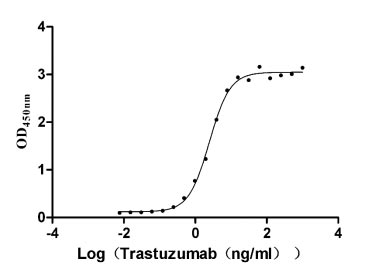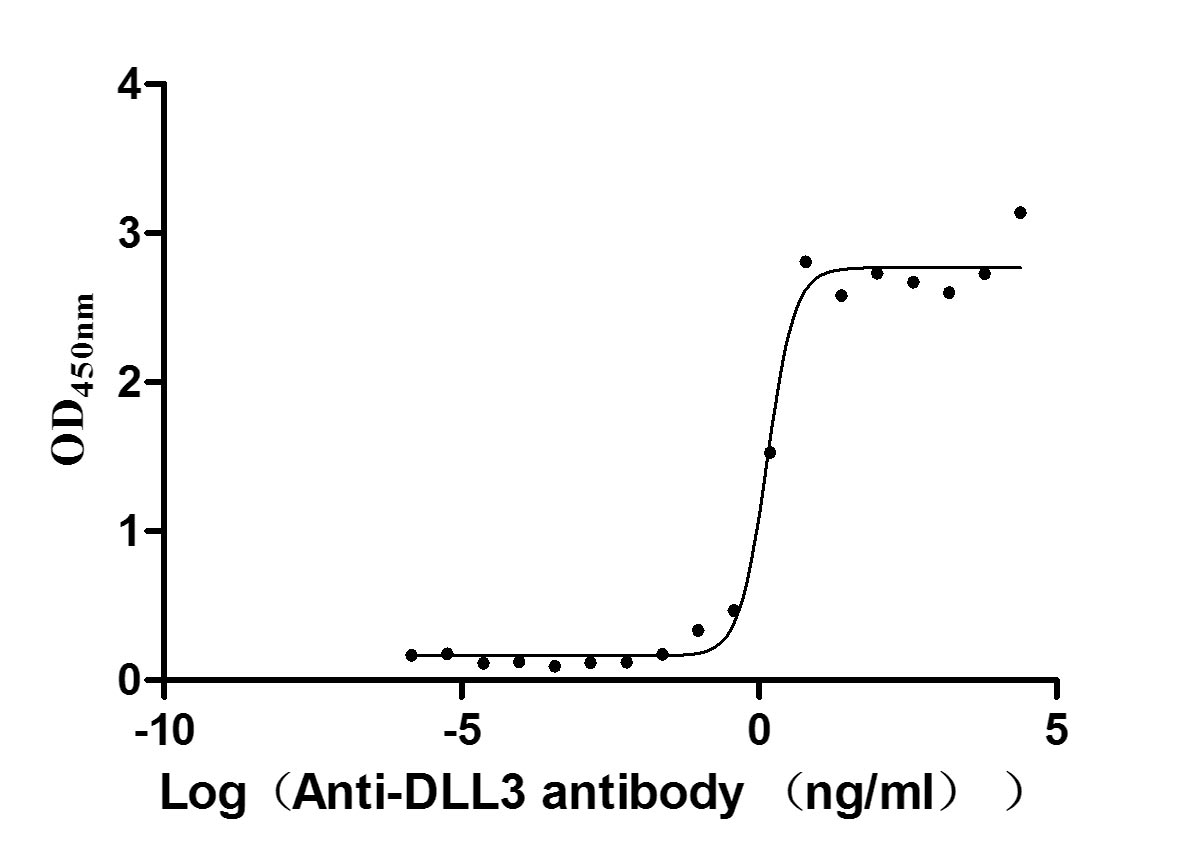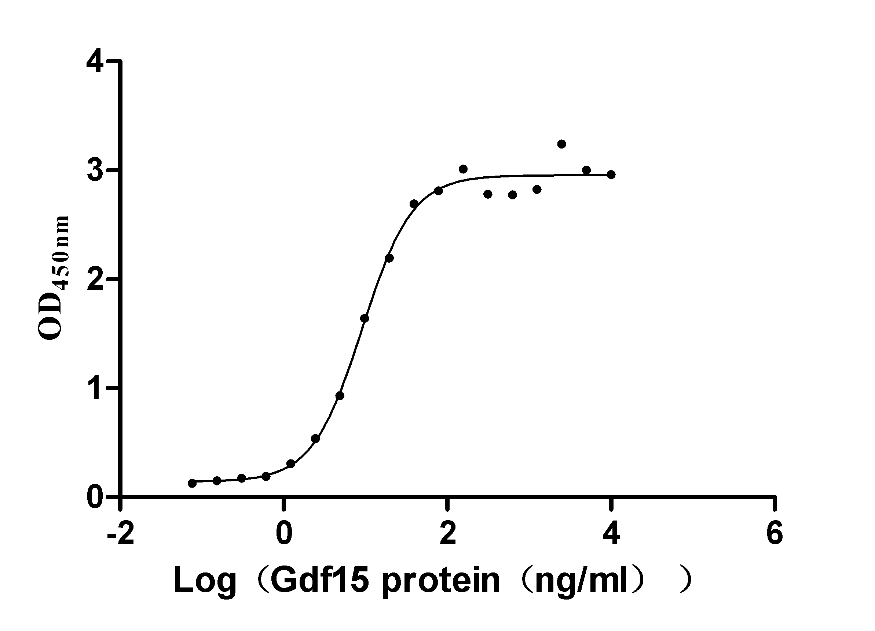Recombinant Mouse Ovarian cancer G-protein coupled receptor 1 (Gpr68)
-
货号:CSB-CF805861MO
-
规格:
-
来源:in vitro E.coli expression system
-
其他:
产品详情
-
基因名:
-
Uniprot No.:
-
别名:Gpr68; Ogr1; Ovarian cancer G-protein coupled receptor 1; G-protein coupled receptor 68; Sphingosylphosphorylcholine receptor
-
种属:Mus musculus (Mouse)
-
蛋白长度:full length protein
-
表达区域:1-365
-
氨基酸序列MGNITTENSSLSCPIDHTIHQTLAPVVYVTVLVVGFPANCLSLYFGYLQIKARNELGVYL CNLTIADLFYICSLPFWLQYVLQHDDWSHGDLSCQVCGILLYENIYISVGFLCCISIDRY LAVAHPFRFHQFRTLKAAVGVSVLIWAKELLTSIYFLNHKEVIEDEDQHRVCFEHYPIQA WQRSINYYRFLVGFLFPICLLLASYQGILRAVRRSHGTQKSRKDQIQRLVLSTVVIFLAC FLPYHVLLLVRSLWERNCEFAKSIFNVYHFSLLLTSFNCVADPVLYCFVSETTHRDLARL RGACLAVLTCSRTSRAREAYPLGAPEASGKSGAQGEEPELLTKLHSAFQTPSSLGVGGPS TVGLA
Note: The complete sequence including tag sequence, target protein sequence and linker sequence could be provided upon request. -
蛋白标签:N-terminal 10xHis-tagged
-
产品提供形式:Liquid or Lyophilized powder
Note: We will preferentially ship the format that we have in stock, however, if you have any special requirement for the format, please remark your requirement when placing the order, we will prepare according to your demand. -
缓冲液:Lyophilized from Tris/PBS-based buffer, 6% Trehalose, pH 8.0
-
储存条件:Store at -20°C/-80°C upon receipt, aliquoting is necessary for mutiple use. Avoid repeated freeze-thaw cycles.
-
保质期:The shelf life is related to many factors, storage state, buffer ingredients, storage temperature and the stability of the protein itself.
Generally, the shelf life of liquid form is 6 months at -20°C/-80°C. The shelf life of lyophilized form is 12 months at -20°C/-80°C. -
货期:Basically, we can dispatch the products out in 1-3 working days after receiving your orders. Delivery time may differ from different purchasing way or location, please kindly consult your local distributors for specific delivery time.Note: All of our proteins are default shipped with normal blue ice packs, if you request to ship with dry ice, please communicate with us in advance and extra fees will be charged.
-
注意事项:Repeated freezing and thawing is not recommended. Store working aliquots at 4°C for up to one week.
-
Datasheet & COA:Please contact us to get it.
相关产品
靶点详情
-
功能:Proton-sensing receptor involved in pH homeostasis. May represents an osteoblastic pH sensor regulating cell-mediated responses to acidosis in bone. Mediates its action by association with G proteins that stimulates inositol phosphate (IP) production or Ca(2+) mobilization. The receptor is almost silent at pH 7.8 but fully activated at pH 6.8. Also functions as a metastasis suppressor gene in prostate cancer.
-
基因功能参考文献:
- The signal transduction activity of OGR1 is regulated by pH-dependent internalization and recycling to the plasma membrane. PMID: 29655915
- In rapidly growing mice, lack of OGR1 leads to increased bone mass with increased bone turnover and a greater increase in bone formation than resorption. PMID: 26880453
- Here, we demonstrate that metals, Fe, Zn, Co, Ni and Mn are the novel OGR1 agonists, which can singly activate OGR1 in neutral pH. PMID: 26053506
- CaSR and OGR1 reciprocally inhibit signaling through each other in central neurons, and that this is lost in their transformed counterparts. Acidification potentiates OGR1. PMID: 26261299
- acidic pH stimulates cGMP accumulation preferentially through the OGR1/Gq/11 proteins/phospholipase C/Ca(2+)/nNOS in N1E-115 neuronal cells. Akt-mediated phosphorylation of nNOS PMID: 25025574
- OGR1 on dendritic cells is critical for their migration to draining lymph nodes, which, in turn, stimulates Th2 phenotype change and subsequent induction of airway inflammation and hyperreactivity. PMID: 24244587
- Deficiency of proton-sensing ovarian cancer G protein-coupled receptor 1 attenuates glucose-stimulated insulin secretion. PMID: 22733973
- OGR1 alters the pH-sensitive response of NHE and H+-ATPase activity in proximal tubules. PMID: 22508039
- regulator of G-protein signaling 18 acts as a negative regulator of the acidosis-induced osteoclastogenic OGR1/NFAT signaling pathway PMID: 17576169
- OGR1 induces an increase in Ca(i) in response to acidic medium and is a prime candidate for an osteoblast proton sensor. PMID: 18847331
- OGR1's role in osteoclastogenesis is not strong enough to affect overall bone development. PMID: 19479052
显示更多
收起更多
-
亚细胞定位:Cell membrane; Multi-pass membrane protein.
-
蛋白家族:G-protein coupled receptor 1 family
-
组织特异性:Expressed in the lung, testis, heart, brain, spleen, thymus, brown fat, small intestine, colon, peripheral blood leukocytes, macrophages, stomach, ovary and white fat but not in the liver, kidney, and skeletal muscle. Expression in the prostate is weak bu
-
数据库链接:
KEGG: mmu:238377
STRING: 10090.ENSMUSP00000057510
UniGene: Mm.32160
Most popular with customers
-
Recombinant Human Receptor tyrosine-protein kinase erbB-2 (ERBB2), partial (Active)
Express system: Mammalian cell
Species: Homo sapiens (Human)
-
Recombinant Human Delta-like protein 3 (DLL3), partial (Active)
Express system: Mammalian cell
Species: Homo sapiens (Human)
-
Recombinant Mouse GDNF family receptor alpha-like (Gfral), partial (Active)
Express system: Mammalian cell
Species: Mus musculus (Mouse)
-
Recombinant Human Zymogen granule protein 16 homolog B (ZG16B) (Active)
Express system: Mammalian cell
Species: Homo sapiens (Human)
-
Recombinant Human Claudin-4 (CLDN4)-VLPs (Active)
Express system: Mammalian cell
Species: Homo sapiens (Human)
-
Recombinant Human Interleukin-17A (IL17A) (T26A) (Active)
Express system: Baculovirus
Species: Homo sapiens (Human)
-
Recombinant Human Alkaline phosphatase, germ cell type (ALPG) (Active)
Express system: Mammalian cell
Species: Homo sapiens (Human)
-
Recombinant Human Cell adhesion molecule 1 (CADM1), partial (Active)
Express system: Mammalian cell
Species: Homo sapiens (Human)







-AC1.jpg)












